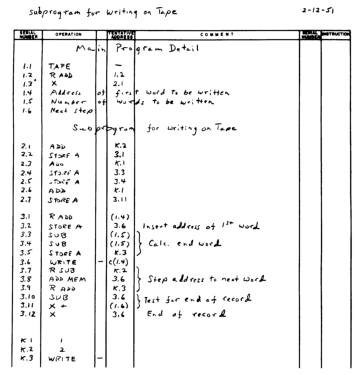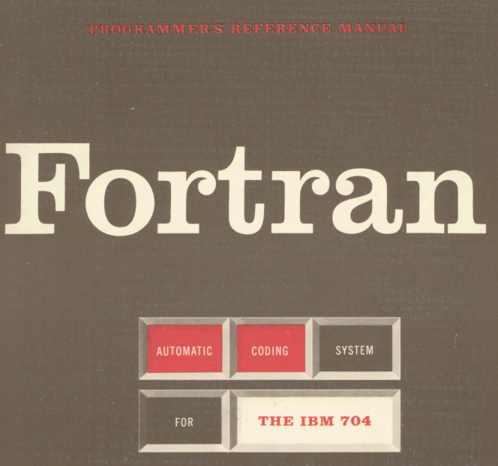Early software on the IBM 7x
In the beginning, there was nothing. At the launch of the 701 in 1952, IBM would happily sell (or rent) you a computer, but it came with no operating system and no high-level compilers, as these did not exist yet. What you had was machine code and some early assemblers.
Indeed, IBM was not really in the business of selling software at all. IBM would facilitate meetings amongst its customers on ways to program its computers. Techniques to automatically assemble machine language programs were discussed, but each site would adapt these for its own use. Over time, through user groups such as SHARE, assemblers and subroutine libraries were distributed and improvements suggested. An example of some of these for the 704 can be seen at Richard Cornwell's page.
Using the computer without an operating system
How then was the computer used?

Sample hand written program for the 701. Source: IBM's early computers by Charles J Bashe.
According to George F. Ryckman, who worked with a 701 at General Motors Research Laboratories in the early 1950's:
Each user was allocated a minimum 15-minute slot, of which time he usually spent 10 minutes in setting up the equipment to do his computation. He mounted his own tapes and set up the card reader, card punch, and printer to carry out his computation. By the time he got his calculation going, he may have had only 5 minutes or less of actual computation completed-wasting two thirds of his time slot.
For the programmer, this was not a great experience as they had limited time to debug their programs. For the computer owners it was even worse, given the great expense of the machine, most of the time the CPU was sitting idle as programmers set up their program and tried to work out what was going on,
Early high level languages
The idea of a programming language operating at a higher level than assembly had been discussed since the 1940s, with one of the first fully working ones being Short Code for the UNIVAC. Assembly language programmers expressed scepticism: running a compiler would add to the time taken to produce the machine code, and how could code produced by a compiler compile to their own hand-optimised code?

Cover of the 704 Fortran manual. Source: IBM Manual at bitsavers.org
Fortran, developed between 1956 and 1957 by John Backus and a team at IBM, helped answer these questions. It had a syntax that allowed easy translation of mathematical formulae into code and was fairly quick to run. Scientists and researcher adopted it quickly, and it spread to many other contemporary computers.
A simple Fortran program to print Hello World 5 times:
C HELLO WORLD PROGRAM
DO 10 I=1,5
WRITE (6,20)
10 CONTINUE
STOP
20 FORMAT(13H HELLO, WORLD)
ENDAnother early language was MAD, the Michigan Algorithm Decoder. Developed at the University of Michigan in 1959 for the 704, it provided a more English-like syntax inspired by early drafts of the Algol language, and had a fast compiler.
The equivalent of the above program in MAD:
* HELLO WORLD PROGRAM
THROUGH LOOP, FOR I=1, 1, I .G. 5
PRINT COMMENT $HELLO, WORLD$
LOOP CONTINUE
END OF PROGRAMBatch operating systems
High level languages like these helped speed the development process, but the problem of efficient machine utilisation was still present.
The solution to this was batch processing. A series of jobs for several programmers could be grouped together into a batch of work that could be executed by the computer in sequence with minimal set up time. Programmers would submit their code and running instructions to the operator, who would prepare a set of tapes to load into the computer and execute. After the batch was run, a tape containing items to print or punch to cards would be transferred to a smaller computer, and the physical paper/cards delivered to the programmers.
The development of these batch operating systems again started with customers contributing and sharing code: examples are the SHARE Operating System and Bell Labs' BESYS. Eventually, IBM adapted the Fortran Monitor System (used at MIT) and released this as IBSYS.
An example of a set of control cards to compile the above Fortran code, run it and produce a listing.
$JOB HELLO WORLD $EXECUTE FORTRAN $ID HELLO * XEQ * LIST8
Along with increased utilisation, this helped efficiency as jobs had to be submitted in a way that was understandable by the computer. The set up tasks were also done by experienced operators who used the machine constantly rather than programmers who did not.
The disadvantages were latency and lack of debugability. It could take hours or days for the batch to finish and each programmer to receive their output. Minor errors in the program that could have been quickly fixed in the "open shop" method of operation would now have to wait for the next batch run.
The solution to this was time-sharing, of which CTSS was one early example. Next time we'll look at CTSS, starting with the supervisor.
Further reading and things to try
- IBM's early computers by Charles J Bashe describes the hardware and software of the IBM 7x and other early computers.
- Classic operating systems by Per Brinch Hansen has a chapter on how the 701 was used in an "open shop" manner at General Motors Research Laboratory, plus many other details on operating system history.
- Early assemblers such as UASAP can be run on simh, along with a manual.
- IBSYS is available to run on both s709 and simh, with manuals on bitsavers.
Questions, corrections, comments
Please email me at rupert@timereshared.com and I will update this page.